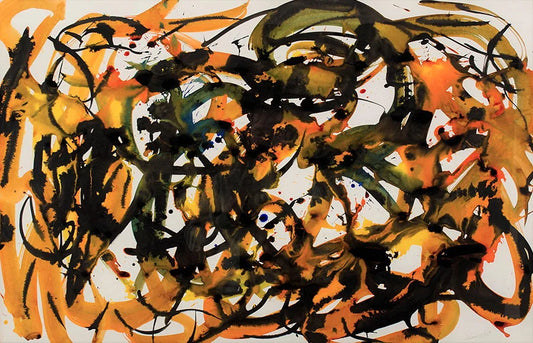Collection: Jérome, Jean-Paul
-
Jean-Paul Jérome - Untitled / Color Inks/Paper, 26×40 in // 66.04×101.60 cm
Vendor:Galerie NuancesRegular price $0.00Regular price
Request for information
Jean-Paul Jérôme, a great abstract painter
Canadian master, Jean-Paul Jérôme, ARC (Royal Canadian Academy of Arts), painter, draftsman, sculptor, visual artist, central figure of abstraction in Quebec was born in Montreal, Quebec on February 19, 1928 (died August 14, 2004). He studied at the École des beaux-arts de Montréal from 1945 to 1952. Jean-Paul Jérôme was one of the signatories of the "Manifeste Plasticiens" (which dissociates itself from the Automatistes) and co-founder of this movement in 1955 with Jauran (Rodolphe de Repentigny), Louis Belzile and Fernand Toupin. He spent time in Paris from 1956 to 1958. In 1978, he became a member of the Royal Canadian Academy of Arts.
A painter with many talents
Jean-Paul Jérôme expressed his art through several mediums such as: acrylic, wood, ceramics, ink, oil, brass, pastel, tapestry, glass, etc. In the "Manifesto of the Plasticians" the group indicates "the Plasticians are attached above all, in their work, to the plastic facts: tone, texture, forms, lines, final unity that is the painting, and the relationships between these elements, elements assumed as ends." "All my life, I have loved the purity of form, the resonance of color." Jean-Paul Jérôme
The works of Jean-Paul Jérôme can be found in several public and private collections in Canada (including the Montreal Museum of Fine Arts, the National Gallery of Canada, the Montreal Museum of Contemporary Art, the Musée national des beaux-arts du Québec, the Musée d'art de Joliette, the Sherbrooke Museum of Fine Arts, the Musée régional de Rimouski, the Musée du Bas-Saint-Laurent, etc.) and in Europe.
ADDITIONAL ARTICLE(S):
Jean-Paul Jerome (1928)
Jean-Paul Jérôme's work went through several phases over the course of his long career. In the mid-1950s, he created works that, although already non-figurative and geometric in style, remained suggestive. The paintings of this period retain a distant but no less real kinship with his Cubist-inspired works, which he created in the early 1950s.
His plastic preoccupation, modulating the surface through a play of dynamic forms, translates into an interaction of masses created by a certain formal fluidity. The works of 1954-1955 are, in this sense, particularly inspired. Very early on, however, he abandoned the geometric rigor of the plastic artists. After a period of research and reflection, he returned with highly evocative abstract landscapes.
Jérôme has always demonstrated a marked taste for change. Thus, in his work, not only does the artist explore multiple paths, but he rarely relies on the same foundations for long. The pace of these various transformations is particularly rapid.
Upon his return to Montreal in 1958, after a three-year stay in Paris, Jean-Paul Jérôme began a career teaching visual arts, a profession he would pursue until 1973. Thereafter, he devoted himself almost exclusively to his work. In the 1980s, his pictorial space, essentially energized by line, became highly geometric. His palette generally consisted of muted tones and earth tones. Unlike other visual artists, he explored, through complex structures, a surface where depth of field played a major role. The early 1990s saw an explosion. Vivid, vibrant color flooded into both his painting and his sculpture. Jérôme displayed a renewal rarely seen in the artistic world. His refined forms were surrounded by masses or black lines that enlivened and disrupted the surface. Great Jérôme!
Source: Robert Bernier, Painting in Quebec since the 1960s, Les Éditions de l'Homme, 2002, Jérôme Jean-Paul Jérôme (1928), page 90-91.

